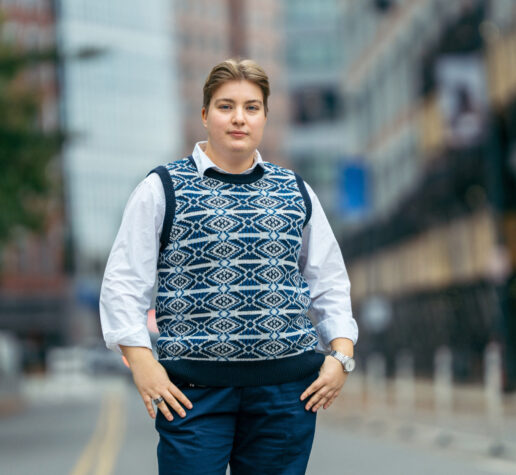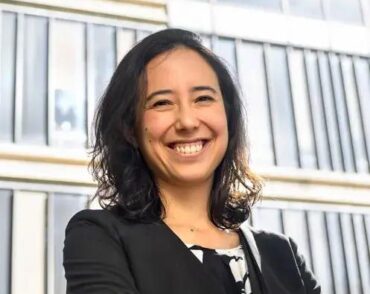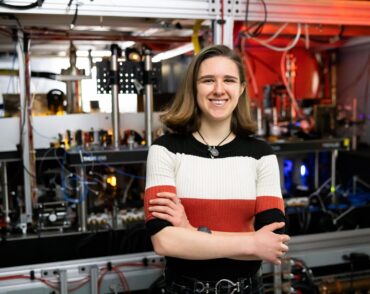
The science and art of complex systems
Senior and physics major Gosha Geogdzhayev devotes himself to climate modeling and writing poetry.
As a high school student, Gosha Geogdzhayev attended Saturday science classes at Columbia University, including one called The Physics of Climate Change. “They showed us a satellite image of the Earth’s atmosphere, and I thought, ‘Wow, this is so beautiful,’” he recalls. Since then, climate science has been one of his driving interests.
With the MIT Department of Earth, Atmospheric and Planetary Sciences and the BC3 Climate Grand Challenges project, Geogdzhayeva is creating climate model “emulators” in order to localize the large-scale data provided by global climate models (GCMs). As he explains, GCMs can make broad predictions about climate change, but they are not proficient at analyzing impacts in localized areas. However, simpler “emulator” models can learn from GCMs and other data sources to answer specialized questions. The model Geogdzhayev is currently working on will project the frequency of extreme heat events in Nigeria.
A senior majoring in physics, Geogdzhayev hopes that his current and future research will help reshape the scientific approach to studying climate trends. More accurate predictions of climate conditions could have benefits far beyond scientific analysis, and affect the decisions of policymakers, businesspeople, and truly anyone concerned about climate change.
“I have this fascination with complex systems, and reducing that complexity and picking it apart,” Geogdzhayev says.
His pursuit of discovery has led him from Berlin, Germany, to Princeton, New Jersey, with stops in between. He has worked with Transsolar KlimaEngineering, NASA, NOAA, FU Berlin, and MIT, including through the MIT Climate Stability Consortium’s Climate Scholars Program, in research positions that explore climate science in different ways. His projects have involved applications such as severe weather alerts, predictions of late seasonal freezes, and eco-friendly building design.
The written word
Originating even earlier than his passion for climate science is Geogdzhayev’s love of writing. He recently discovered original poetry dating back all the way to middle school. In this poetry he found a coincidental throughline to his current life: “There was one poem about climate, actually. It was so bad,” he says, laughing. “But it was cool to see.”
As a scientist, Geogdzhayev finds that poetry helps quiet his often busy mind. Writing provides a vehicle to understand himself, and therefore to communicate more effectively with others, which he sees as necessary for success in his field.
“A lot of good work comes from being able to communicate with other people. And poetry is a way for me to flex those muscles. If I can communicate with myself, and if I can communicate myself to others, that is transferable to science,” he says.
Since last spring Geogdzhayev has attended poetry workshop classes at Harvard University, which he enjoys partly because it nudges him to explore spaces outside of MIT.
He has contributed prolifically to platforms on campus as well. Since his first year, he has written as a staff blogger for MIT Admissions, creating posts about his life at MIT for prospective students. He has also written for the yearly fashion publication “Infinite Magazine.”
Merging both science and writing, a peer-reviewed publication by Geogdzhayev will soon be published in the journal “Physica D: Nonlinear Phenomena.” The piece explores the validity of climate statistics under climate change through an abstract mathematical system.
Leading with heart
Geogdzhayev enjoys being a collaborator, but also excels in leadership positions. When he first arrived at MIT, his dorm, Burton Conner, was closed for renovation, and he could not access that living community directly. Once his sophomore year arrived however, he was quick to volunteer to streamline the process to get new students involved, and eventually became floor chair for his living community, Burton 1.
Following the social stagnation caused by the Covid-19 pandemic and the dorm renovation, he helped rebuild a sense of community for his dorm by planning social events and governmental organization for the floor. He now regards the members of Burton 1 as his closest friends and partners in “general tomfoolery.”
This sense of leadership is coupled with an affinity for teaching. Geogdzhayev is a peer mentor in the Physics Mentorship Program and taught climate modeling classes to local high school students as a part of SPLASH. He describes these experiences as “very fun” and can imagine himself as a university professor dedicated to both teaching and research.
Following graduation, Geogdzhayev intends to pursue a PhD in climate science or applied math. “I can see myself working on research for the rest of my life,” he says.


